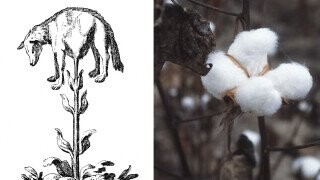The Fabulous Legend Of The Vegetable Lamb

It's Middle Ages Week at Cracked. Put on your tunic, and eat some cabbage!
In the 1300s, a traveler named Sir John Mandeville came to Europe with wild tales of what he had seen abroad. There's a lot we don't know about Sir John Mandeville, including whether he was really a Sir, whether his name was really John Mandeville, and whether he ever actually traveled anywhere, but his stories (which were filled with lies) spread widely.
Among them was news of the Vegetable Lamb of Tartary. In Tartary (an area that's today Mongolia and Russia), he had seen lambs that grow out of the ground. A plant sprouts a gourd, and in this gourd is a lamb. He'd tasted these vegetable lambs himself, and they were delicious.
Don't Miss
For the next few centuries, other stories circulated of the vegetable lambs, and Europeans believed them. Some Europeans, anyway—we don't have any quotes from farmers about what they thought of this idea. Here's one 16th-century poem about the creature (translated into modern English):
Although their bodies, noses, mouths, and eyes,
Of new-yeaned lambs have full the form and guise,
And should be very lambs, save that for foot
Within the ground they fix a living root
Which at their navel grows, and dies that day
That they have browsed the neighboring grass away.
Oh! Wondrous nature of God only good,
The beast hath root, the plant hath flesh and blood.
Accounts about the vegetable lamb varied. Some said it was a single animal in a gourd like that first Mandeville tale, while others said each plant had a series of lambs on stalks, so they could bend to the ground and feed.
People weren't believing in these sheep plants based on faith alone, however. They believed in them because explorers brought specimens from other countries. No complete and living specimens (which presumably couldn't survive the journey), but quantities of wool bound to plants rather than to walking on all fours. People in the Middle Ages were well acquainted with wool, but this new type of wool was new to them.
Of course, it wasn't really wool. This mysterious new material, which did indeed come from plants, was actually what we now call cotton.
This fact came from the One Cracked Fact newsletter. Want more like this, straight from your email inbox, without any ads or popups? Join here:
For more weird old beliefs, check out:
The 6 Craziest Beliefs Entire Cultures Have Held About Sex
Rain Is Caused By Digging Holes
5 Great Scientists Who Believed Wildly Unscientific Things
Follow Ryan Menezes on Twitter for more stuff no one should see.
Top image: Wiki Commons, USDA
